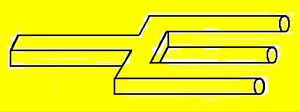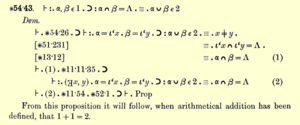Innumeracy

Innumeracy is the physiological condition characterized by the innate inability to grasp the size of sufficiently large but finite numbers. Since there are infinitely many finite numbers, and the human brain has its limits, it follows that there exists an extremely large but finite number n[1] such that every living human on Earth (and by extension every human who has ever and will ever live) cannot possibly conceive of just how big n really is. Therefore, everybody, without exception, suffers from innumeracy; although some people are more innumerate than others.
Onset and diagnosis[edit | edit source]

The early onset of innumeracy can be an intimidating experience for the below‑average person. It can start without warning just by being exposed to pi (the mysterious ratio between a circle's something and something else) for the very first time.
Innumerologists can usually diagnose an acute case within seconds by testing the subject's ability (or inability) to determine exactly how many jelly beans are contained in a jar full of jelly beans. Such persons who fail this most simple and basic test are obviously not qualified to vote in general elections, even for President. Another method of detecting innumeracy involves tricking two patients into playing a game of who can name the biggest number. If the contest lasts any longer than three minutes without resolution, both are absolutely certifiable. Such persons must at all costs be kept away from any form of money in order to prevent runaway inflation.
Case study # 1 (Innumeracy of One)[edit | edit source]

The first mathematician to diagnose his own innumeracy was Bertrand Russell, when he came to realize that he was having immense difficulty moving past page 379 of his grand opus Principia Mathematica. After having successfully proved, after many years of hard and grueling labor, that 1+1=2, Russell simply ran out of steam. He corresponded by snail‑mail with his bitter old rival David Hilbert, his bitter young rival Kurt Gödel, and his former elementary school teacher,[2] but to no avail. They all laughed derisively at Russell's crippling disability, the unfeeling bastards. This was in spite of the fact that they all shared the same debilitating condition, albeit in vastly different orders of magnitude.
Russell never completely recovered from his brush with the terrifying collosity of single-digit numbers. Even Albert Einstein, who could himself barely comprehend the process of integrating an Abelian groupoid of topological fibre bundles over an embedded non‑Euclidean Riemann manifold supplied with pseudohyperbolic coordinates,[3] couldn't quite figure out what the hell Russell was going on about. And so he (Russell) died, brokenhearted and clueless.
Case study # 2 (Innumeracy of Another One)[edit | edit source]
Ronald "McDonald" Graham (of Graham's number fame) was one of the most famous and innumerate mathematicians of all time, which really isn't saying much. His initial overestimate[4] of how many edges a cube has (supposably twelve) shocked and awed the vast majority of his colleagues: Fewer than half of them (about 437 billion trillion quadrillion) couldn't even figure out what the hell[5] Graham was going on about.[6]
After many long years of hard and grueling labor working in a Californian illegal-migrant sweatshop for pennies an hour, since nobody ever made any real money just doing mathematics, Graham returned to the problem at hand and attempted to trim the excess fat from his somewhat unwieldy theorem. It was only a random chance encounter with a gifted second-grader by the name of Alonzo "Ñ" Garcia who set the elderly Graham on the proper path: "Why don't you just count them, you doofus?" And thus Ronald Graham finally got awarded his first and only Nobel Prize for Mathematics.[7]
Unfortunately, Graham died in 2020, well before completing his edge-counting endeavor, thus leaving the remainder of the task to future generations. His last will and testament donated the original cube to the University of California, Berkeley,[8] where it remains standing, vandalized with embellished with colorful spray-painted BLM graffiti art to this day.
Case study # U (Innumeracy of You)[edit | edit source]
You are so innumerate you can't count to 21 without taking your clothes off. You are so innumerate you think text-messaging numbers are way too complicated. You are so innumerate you have trouble figuring out your income tax in spite of never having held a job. You are so innumerate you think clocks and calendars were invented to torture people. You are so innumerate you don't believe one is the loneliest number that you'll ever do. You are so innumerate you wonder how many Wonder Twins there are. You are so innumerate you think it doesn't matter what you do with your fingers in public. You are so innumerate you describe yourself as a people-person. You are so innumerate even Sesame Street dropouts pity you. You are so innumerate you think the empty set is hiding something from you. You are so innumerate dogs can differentiate numerical quantities better than you can. You are so innumerate you can't even comprehend the process of integrating an Abelian groupoid of topological fibre bundles over an embedded non‑Euclidean Riemann manifold supplied with pseudohyperbolic coordinates. And I didn't even mention that atrocious haircut etc.
Case study # ∞[edit | edit source]
As for me, I stopped counting when I was 35. Damn, I hate birthday parties.
See also[edit | edit source]
An indeterminate number of footnotes[edit | edit source]
- ↑ The actual size of n (also known as the Nth number) is pretty hard to determine, since mathematicians who do nothing but invent ridiculously large numbers for no good reason are often dismissed as cranks.
- ↑ The exact identity of Bertrand Russell's former elementary school teacher was never actually established, partly due to his/her never having published a paper on higher mathematics, but mostly due to his/her being thrown under a runaway school bus by an anonymous assailant immediately after Russell graduated second grade.
- ↑ What a doofus!
- ↑ Graham's number is so unbelievably huge that you couldn't possibly fit it on the left margin of this Uncyclopedia article, even if was rendered in a substantially smaller font.
- ↑ Half the people you know are below average.
- ↑ The other half know you.
- ↑ This was, in fact, the first and only Nobel Prize for Mathematics ever offered by the Royal Swedish Academy of Sciences; and they (the Nobel Committee) apparently have no intention of ever traveling down that path again.
- ↑ The Graham Cube is proudly displayed in the middle of the Berkeley Quad, for the enjoyment of all educated Californians.
- ↑ One?
- ↑ Are you sure?

